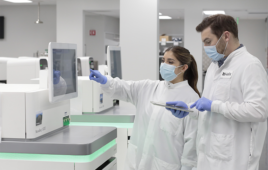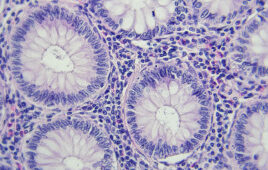A genome-wide scan of millions of genetic mutations has revealed four new DNA hotspots that affect the risk for psoriasis; a national group of researchers led by the University of Michigan and including several from the University of Utah School of Medicine has shown in a study.
The study also confirmed that two other previously identified DNA sites, discovered by researchers at the University of Utah and Celera Group, have a high association with psoriasis, an autoimmune disease that can affect the joints and cause sore, itchy patches of skin.
The study was led by James T. Elder, M.D., Ph.D., a dermatologist who heads a group at the University of Michigan with long-standing interest in and an international reputation for its work in the genetics of psoriasis, and Goncalo Abecasis, Ph.D., a biostatistician at the University of Michigan. They elected to make the study a collaboration with researchers at Washington University in St. Louis and the University of Utah. Gerald G. Krueger, M.D., professor of dermatology and Benning Presidential Endowed Chair holder at the U of U, and his colleague Kristina Callis Duffin, M.D., assistant professor of dermatology, led the Utah portion of the study.
Krueger and Duffin said the study is important for several reasons.
‘First, it shows the efficacy of using this (genome-wide) approach to further understand this disease,’ Krueger said. ‘Second, it confirmed findings we reported in 2007 of polymorphisms (mutations) in the IL-12/23 pathways. Third, we now find a third polymorphism in this same cluster, IL-23A. Fourth, a treatment that knocks down IL-12 and IL-23 recently has been shown to be a very effective treatment for psoriasis.’
This, plus the clustering of polymorphisms the IL-12/23 pathways, makes it apparent that this pathway is important to the pathogenesis of psoriasis, according to Krueger.
The researchers took advantage of a new technology called genome-wide association studies (GWAS). At the heart of this is selecting from the more than 10 million polymorphisms (mutations) in the human genome a group of polymorphisms that are predicted to be informative of association with disease, in this case psoriasis. The platform used in this experiment contained 438,670 polymorphisms. To assess for psoriasis-associated polymorphisms each of the 1,359 subjects with psoriasis and a control group of 1,400 people without the disease had their DNA probed for each of the 438,670 polymorphisms. After identifying 18 DNA sites with the highest associations with psoriasis, the researchers expanded the study to include 5,048 people with psoriasis and 5,051 without the disease. From that, the researchers identified seven potential genetic hotspots for psoriasis.
Three of those sites—IL-12B, IL-23R, and IL-13 —were first identified in earlier studies by Krueger and other University of Utah and Celera Group researchers. A third gene, HLA-C, has the strongest association with psoriasis and has been found numerous times by many investigators. Most recently, the Elder group showed this association appears to be linked to an allele of HLA-C called *0602, and the latest study confirms this, once again. Three new polymorphisms reported in the study—IL-23A, TNFAIP3, and TNI1—had not been linked to the skin and joint disorder, and in addition there has been confirmation of IL-13 and a closely linked partner IL-4.
The researchers concluded that IL-12B and IL-23-R encode proteins that bind to IL-23A and that mutations in any of those genes may predispose people to immune responses that lead to psoriasis. The study also showed that genetic signals from two regulatory elements, TNFAIP3 and TNI1, of TNF-alpha, may be faulty regulating the TNF-alpha induced inflammation of psoriasis and psoriatic arthritis. Polymorphisms of TNFAIP3 and TNI1 are also associated with two other autoimmune diseases, lupus, and rheumatoid arthritis.
The number of DNA sites discovered to have strong associations with psoriasis has increased from one to 10 in the past 18 months. But many more polymorphisms probably are associated with the disease, according to Krueger. He believes the number that ultimately will be associated with psoriasis could be close to 300.
Once all the gene mutations connected to psoriasis have been identified, researchers may be able to develop a genetic profile to predict the risk of developing the disease, the type of disease, and response to treatment. Krueger expects that quite soon a gene chip containing psoriasis-associated genetic mutations will be available to aid in the study of the disease.
Release Date: January 26, 2009
Source: University of Utah Health Sciences
Filed Under: Genomics/Proteomics




